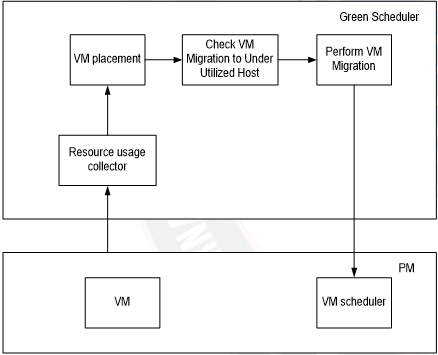Adaptive Energy-Optimized Consolidation Algorithm
Main Article Content
Abstract
We have been hearing about cloud computing for quite a long time now. This type of computing is booming and emerging as a popular computing paradigm for its scalability and flexibility in nature. Cloud computing provides the provision of service on-demand, on-demand resources supply and services to end-users. However, energy consumption and energy wastage are becoming a major concern for cloud providers due to its direct impression on costs required for operations and carbon emissions. To tackle this issue, Adaptive Energy-Optimized Consolidation Algorithm has been proposed to efficiently manage energy consumption in cloud environments. This algorithm involves sharing by dividing, in this process resource allocation is done into two different phases, those are, consolidation of tasks and consolidation of resources. Compared to single-task consolidation algorithms, the proposed two-phase Adaptive energy optimized consolidation algorithm shows improved performance in terms of energy efficiency and resource utilization. The results of experiments conducted using a cloud-sim show the effectiveness of the proposed algorithm in decreasing energy consumption while maintaining the quality-of-service requirements of computing in cloud.
The need for an hour is to automate things without human intervention. Thus, using Autonomous computing refers to a type of computing system that is capable of performing tasks and making decisions without the intervention of humans. This type of system typically relies on Artificial.Intelligence, Machine.Learning, and other futuristic technologies to study the data, identify patterns, and make decisions based on that data. Cloud computing can certainly be incorporated into an autonomous computing system. The performance of an automated computing environment depends on a various factor, considering the quality of the different algorithms used, also the amount and quality of various data available to the system, the computational resources available, and the system's ability to learn and adapt over time. However, by incorporating cloud computing, an autonomous computing system can potentially access more resources and process data more quickly, which can improve its overall performance.
Article Details
References
Power management in cloud computing using green algorithm,IEEE-International Conference On Advances In Engineering, Science And Management (ICAESM -2012) March 30, 31, 2012.
A Study on Green Cloud Computing, International Journal of Grid and Distributed Computing Vol.6, No.6 (2013), pp.93-102.
A. Jain, M. Mishra, S. Kumar Peddoju and N. Jain, (Eds.), “Energy Efficient Computing-Green Cloud Computing”, Proceedings of the International Conference of the Energy Efficient Technologies for Sustainability (ICEETS), (2013) April 10-122; Nagercoil.
Abhinandan P. M., “Two Phase Consolidation Algorithm for Efficient Energy Consumption in Cloud Computing”, International Journal of Computer Science Trends and Technology (IJCST) – Volume 6 Issue 6, Nov-Dec 2018.
Anton Beloglazov and Rajkumar Buyya, "Energy Ef cient Resource Management in Virtualized Cloud Data Centers," in 10th IEEE/ACM International Conference on Cluster, Cloud and Grid Computing, 2010.
Anton Beloglazov and Rajkumar Buyya, "Adaptive Threshold-Based Approach for Energy-Ef cient Consolidation of Virtual Machines in Cloud Data Centers," in ACM/IFIP/USENIX 11th International Middleware Conference, 2010.
Anton Beloglazov, Jemal Abawajy, and Rajkumar Buyya, "Energy-Aware Resource Allocation Heuristics for Efficient Management of Data Centers for Cloud Computing," journal of Future Generation Computer Systems, vol. 27, no. 8, April 2011.
Rodrigo N Calheiros, Rajiv Ranjan, Anton Beloglazov, César A. F De Rose, and Rajkumar Buyya, CloudSim: A Toolkit for Modeling and Simulation of Cloud Computing Environments and Evaluation of Resource Provisioning Algorithms. USA: Wiley Press, 2010.
SUN Microsystems, "IntroductIon to Cloud Computing Architecture," White Paper 2009.
EMC 2008 Annual overview Releasing the power of infonnation, http://www.emc.comJ digital_universe.
R. Bianchini and R.Rajamony, "power and energy management for server systems," IEEE Computer, voI.37,no. ll,pp.68-74,2004.
S.Albers, "Energy -Efficient Algorithms," Communications of the ACM, vo1.53, no.5, pp.86-96, May 2010.
Peter Mell and Tim Grance, "The Nist Definition of Cloud Computing," National Institute of Standard and Technology (NIST), Standard Definition 2008.
Abhinay B. Angadi, Akshata B. Angadi, Karuna C. Gull, (2013) “Growth of New Databases & Analysis of NOSQL Data-stores”, International Journal of Advanced Research in Computer Science and Software Engineering (IJARCSSE) Volume 3, Issue 6, ISSN: 2277-128X. pp. 1306-1319, June, 2013.
Abhinay B. Angadi, Akshata B. Angadi, Karuna C. Gull, (2013) “Security Issues with Possible Solutions in Cloud Computing-A Survey”, International Journal of Advanced Research in Computer Engineering & Technology (IJARCET) Volume 2, Issue 2, ISSN: 2278-1323, pp.652-661, February, 2013.

